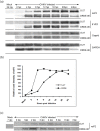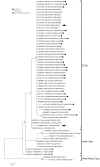A novel 2006 Indian outbreak strain of Chikungunya virus exhibits different pattern of infection as compared to prototype strain
- PMID: 24465661
- PMCID: PMC3896419
- DOI: 10.1371/journal.pone.0085714
A novel 2006 Indian outbreak strain of Chikungunya virus exhibits different pattern of infection as compared to prototype strain
Abstract
Background: The recent re-emergence of Chikungunya virus (CHIKV) in India after 32 years and its worldwide epidemics with unprecedented magnitude raised a great public health concern.
Methods and findings: In this study, a biological comparison was carried out between a novel 2006 Indian CHIKV outbreak strain, DRDE-06 and the prototype strain S-27 in mammalian cells in order to understand their differential infection pattern. Results showed that S-27 produced maximum number of progenies (2.43E+06 PFU/ml) at 20 to 24 hours post infection whereas DRDE-06 produced more than double number of progenies around 8 hours post infection in mammalian cells. Moreover, the observation of cytopathic effect, detection of viral proteins and viral proliferation assay confirmed the remarkably faster and significantly higher replication efficiency of DRDE-06. Moreover, our mutational analysis of whole genome of DRDE-06 revealed the presence of nineteen mutations as compared to S-27, whereas the analysis of 273 global isolates showed the consistent presence of fifteen out of nineteen mutations in almost all outbreak isolates. Further analysis revealed that ∼46% of recent outbreak strains including DRDE-06 do not contain the E1-A226V mutation which was earlier shown to be associated with the adaptation of CHIKV in a new vector species, Aedes albopictus.
Conclusions: A novel 2006 Indian CHIKV outbreak strain, DRDE-06 exhibits different pattern of infection as compared to prototype strain, S-27. This might be associated to some specific mutations observed in genome wide mutational analysis in DRDE-06 which emphasizes the need of future experimental investigation.
Conflict of interest statement
Figures





Similar articles
-
Differential susceptibility & replication potential of Vero E6, BHK-21, RD, A-549, C6/36 cells & Aedes aegypti mosquitoes to three strains of chikungunya virus.Indian J Med Res. 2019 Jun;149(6):771-777. doi: 10.4103/ijmr.IJMR_453_17. Indian J Med Res. 2019. PMID: 31496530 Free PMC article.
-
Evaluation of chikungunya virus infection in children from India during 2009-2010: A cross sectional observational study.J Med Virol. 2016 Jun;88(6):923-30. doi: 10.1002/jmv.24433. Epub 2015 Dec 15. J Med Virol. 2016. PMID: 26581026
-
Vector competence of Aedes albopictus for the Indian Ocean lineage (IOL) chikungunya viruses of the 2007 and 2017 outbreaks in Italy: a comparison between strains with and without the E1:A226V mutation.Euro Surveill. 2018 May;23(22):1800246. doi: 10.2807/1560-7917.ES.2018.23.22.1800246. Euro Surveill. 2018. PMID: 29871722 Free PMC article.
-
Chikungunya virus infection: molecular biology, clinical characteristics, and epidemiology in Asian countries.J Biomed Sci. 2021 Dec 2;28(1):84. doi: 10.1186/s12929-021-00778-8. J Biomed Sci. 2021. PMID: 34857000 Free PMC article. Review.
-
Antiviral perspectives for chikungunya virus.Biomed Res Int. 2014;2014:631642. doi: 10.1155/2014/631642. Epub 2014 May 15. Biomed Res Int. 2014. PMID: 24955364 Free PMC article. Review.
Cited by
-
6-Shogaol Exhibits Anti-viral and Anti-inflammatory Activity in COVID-19-Associated Inflammation by Regulating NLRP3 Inflammasomes.ACS Omega. 2023 Jan 6;8(2):2618-2628. doi: 10.1021/acsomega.2c07138. eCollection 2023 Jan 17. ACS Omega. 2023. PMID: 36687062 Free PMC article.
-
Next generation self-replicating RNA vectors for vaccines and immunotherapies.Cancer Gene Ther. 2023 Jun;30(6):785-793. doi: 10.1038/s41417-022-00435-8. Epub 2022 Feb 22. Cancer Gene Ther. 2023. PMID: 35194198 Free PMC article. Review.
-
Radicicol Inhibits Chikungunya Virus Replication by Targeting Nonstructural Protein 2.Antimicrob Agents Chemother. 2021 Jun 17;65(7):e0013521. doi: 10.1128/AAC.00135-21. Epub 2021 Jun 17. Antimicrob Agents Chemother. 2021. PMID: 33903104 Free PMC article.
-
Pyrene-appended bipyridine hydrazone ligand as a turn-on sensor for Cu2+ and its bioimaging application.RSC Adv. 2020 Jan 22;10(7):3646-3658. doi: 10.1039/c9ra09376a. eCollection 2020 Jan 22. RSC Adv. 2020. PMID: 35492648 Free PMC article.
-
P38 and JNK Mitogen-Activated Protein Kinases Interact With Chikungunya Virus Non-structural Protein-2 and Regulate TNF Induction During Viral Infection in Macrophages.Front Immunol. 2019 Apr 12;10:786. doi: 10.3389/fimmu.2019.00786. eCollection 2019. Front Immunol. 2019. PMID: 31031770 Free PMC article.
References
-
- Griffin DE (2007) Alphaviruses In: Fields BN, Knipe DM, PM H, editors. Fields Virology. 5 ed. Philadelphia: Lippincott-Williams & Wilkins 1023–1068.
-
- Powers AM, Brault AC, Tesh RB, Weaver SC (2000) Re-emergence of Chikungunya and O'nyong-nyong viruses: evidence for distinct geographical lineages and distant evolutionary relationships. J Gen Virol 81: 471–479. - PubMed
-
- Diallo M, Thonnon J, Traore-Lamizana M, Fontenille D (1999) Vectors of Chikungunya virus in Senegal: current data and transmission cycles. Am J Trop Med Hyg 60: 281–286. - PubMed
-
- Thaikruea L, Charearnsook O, Reanphumkarnkit S, Dissomboon P, Phonjan R, et al. (1997) Chikungunya in Thailand: a re-emerging disease? Southeast Asian J Trop Med Public Health 28: 359–364. - PubMed
-
- Pialoux G, Gauzere BA, Jaureguiberry S, Strobel M (2007) Chikungunya, an epidemic arbovirosis. Lancet Infect Dis 7: 319–327. - PubMed
Publication types
MeSH terms
Substances
Grants and funding
LinkOut - more resources
Full Text Sources
Other Literature Sources
Medical

